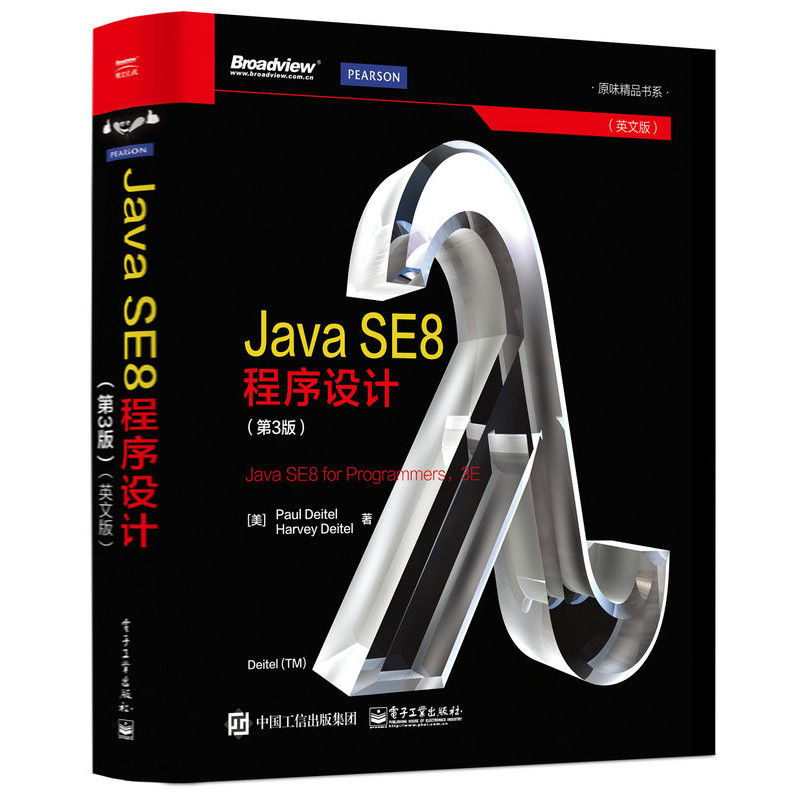
包邮Java SE8程序设计-(第3版)-(英文版)

- ISBN:9787121273278
- 装帧:暂无
- 册数:暂无
- 重量:暂无
- 开本:16开
- 页数:1043
- 出版时间:2016-04-01
- 条形码:9787121273278 ; 978-7-121-27327-8
本书特色
本书沿用了deitel特色的“程序实况解说”,深入探讨了java编程语言和javaapi。通过完整的语法着色、代码高亮、逐行代码的演练和程序输出,全面地介绍了测试程序的概念。书中首先介绍了使用早期java类和对象的方法,然后迅速转移到更高级的主题,包括gui、图形、异常处理、lambda表达式、数据流、功能接口、对象序列化、并发性、泛型、泛型集合、jdbc等。本书包含数百个完整的java可运行示例、数千行成熟的java代码,总结出许多程序开发技巧,帮助你建立强大的应用程序。
内容简介
本书沿用了Deitel特色的“程序实况解说”,深入探讨了Java编程语言和JavaAPI。通过完整的语法着色、代码高亮、逐行代码的演练和程序输出,全面地介绍了测试程序的概念。书中首先介绍了使用早期Java类和对象的方法,然后迅速转移到更高级的主题,包括GUI、图形、异常处理、Lambda表达式、数据流、功能接口、对象序列化、并发性、泛型、泛型集合、JDBC等。本书包含数百个完整的Java可运行示例、数千行成熟的Java代码,总结出许多程序开发技巧,帮助你建立强大的应用程序。
目录
相关资料
推荐序从1995年java 1.0版本发布以来我就一直迷恋它,这种迷恋让我逐渐成为了java开发人员、作家、演讲者、老师和oracle java技术大使。在这个过程中,我一直很荣幸能将paul deitel称为我的同事,并经常使用和推荐他的java书籍。这些java书籍的很多版次都被证明是学习专业课程不可或缺的教科书,所以我们一直使用它们来讲授java 编程语言。我认为这本书是很好的资源,一方面是因为它彻底而深入地覆盖了java概念,另一方面是因为它对有效软件开发进行了必不可少的概念和实践的处理。本书第3版*让我感到兴奋的一些特性如下:?用一章专门介绍了java lambda表达式和流。首先简单地介绍了函数式编程,接着介绍了java lambda表达式,以及如何使用流在集合上执行函数式编程任务。?本书从**版就开始处理并发问题,而多核架构的出现让这个问题变得越来越重要。本书的并发性一章中包含一些定时示例(使用java se 8中引入的新日期/时间api类),这些示例表现出多核带来的性能提升(相对于单核)。?javafx是java的gui/图形/多媒体技术的进一步发展,因此我很高兴能够看到deitel以“程序实况解说”的教学方式来介绍javafx。感谢paul deitel和harvey deitel的这本书为软件开发人员提供了良好的资源。james l. weaveroracle公司java技术大使
作者简介
Paul Deitel,Deitel & Associates有限公司的CEO兼CTO,毕业于麻省理工学院,主修信息技术。他获得了Java认证程序员和Java认证开发员称号,并且是一名Oracle Java冠军程序员。在Deitel & Associate有限公司工作的过程中,他已经为世界各地的客户提供了数百节编程课程,这些客户包括思科、IBM、西门子、Sun Microsystems、戴尔、Fidelity、肯尼迪航天中心、美国国家强风暴实验室、白沙导弹试验场、Rogue Wave Software、波音公司、SunGard Higher Education、北电网络公司、彪马、iRobot、Invensys等。他和本书的合著者Harvey M. Deitel博士是全球畅销编程语言教材、专业书籍和视频的作者。Harvey Deitel博士,Deitel & Associates有限公司的董事长和首席战略官,在计算机领域拥有50多年的经验。Deitel博士获得了麻省理工学院电子工程专业的学士和硕士学位,并获得了波士顿大学的数学博士学位。他拥有丰富的大学教学经验,在1991年与儿子Paul Deitel创办Deitel & Associates有限公司之前,他是波士顿大学计算机科学系的主任并获得了终身任职权。Deitel的出版物获得了国际上的认可,并被翻译为日语、德语、俄语、西班牙语、法语、波兰语、意大利语、简体中文、繁体中文、韩语、葡萄牙语、希腊语、乌尔都语和土耳其语出版。Deitel博士为很多大公司、学术研究机构、政府机关和军方提供了数百场专业编程讲座。
-

硅谷之火-人与计算机的未来
¥15.5¥39.8 -

人工智能的底层逻辑
¥55.3¥79.0 -

软件定义网络(SDN)技术与应用
¥26.9¥39.8 -

专业导演教你拍好短视频
¥13.8¥39.9 -

数学之美
¥41.0¥69.0 -

程序员修炼之道:通向务实的最高境界(第2版)
¥58.9¥89.0 -

谁说菜鸟不会数据分析(入门篇)(第4版)
¥43.8¥69.0 -

自己动手写PYTHON虚拟机
¥35.0¥79.0 -

Photoshop平面设计实用教程
¥14.5¥39.8 -

计算机网络技术
¥13.9¥33.0 -

Excel函数.公式与图表
¥16.4¥48.0 -

.NET安全攻防指南(下册)
¥89.0¥129.0 -

.NET安全攻防指南(上册)
¥89.0¥129.0 -

大模型实战:微调、优化与私有化部署
¥64.4¥99.0 -

多模态数据融合与挖掘技术
¥34.7¥45.0 -

剪映AI
¥58.2¥88.0 -

FINAL CUT短视频剪辑零基础一本通
¥28.9¥39.8 -

数据挖掘技术与应用
¥46.0¥75.0 -

人工智能安全
¥66.4¥109.0 -

计算智能方法
¥34.3¥49.0













